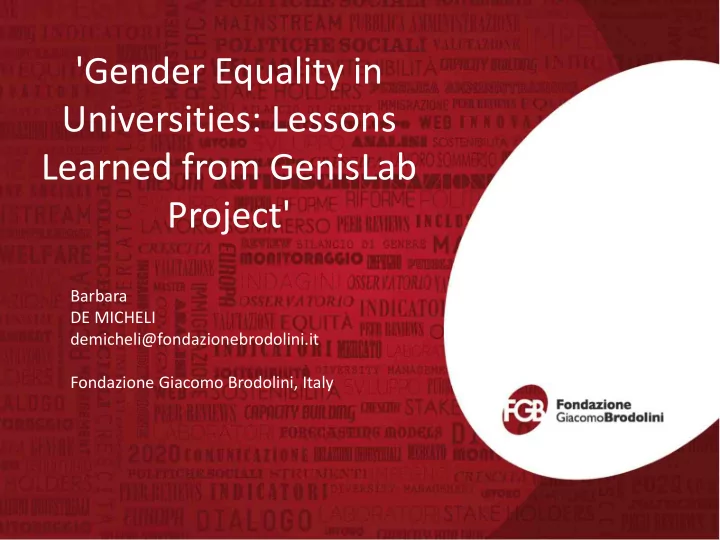

'Gender Equality in Universities: Lessons Learned from GenisLab Project' Barbara DE MICHELI demicheli@fondazionebrodolini.it Fondazione Giacomo Brodolini, Italy
www.fondazionebrodolini.it
www.ingenere.it/en
My presentation - Structural/Institutional change and GEPs - The Genislab case - Challenges
Structural/Institutional change Deep reaching change that alters/transforms the way authority, ressources, information and responsibility flows in an organisation It should be systemic, it is time and ressources consuming, it has great impact.
Structural/Institutional change Why FP7 supports structural change to promote Gender Equality? Decades of gender positive actions did not have the expected impact on women scientist careers (Shefigures 2012, “ scissor ”) Structural changes in research organisations are needed in order to overcome the factors that limit the participation of women in research.
Genis Lab – gender equality and structural change •
Main objectives • to improve women researchers working conditions • to improve women researchers carriers opportunities in research organizations • to improve organizational climate workplace, acting on organizational culture • to fight against negative stereotypes, within research organization but also in a more general context • to contribute to the creation of positive models
GENIS LAB Consortium
GENIS LAB the approach In the framework of Genis Lab structural and institutional change have been understood since the beginning as requiring a systemic approach, suitable to act on different organisational dimensions and moving from an initial (gender) assessment of the organisation. For these reasons the proposed approach to the definition of Gender Action Plans, (named TAP Tailored Action Plans in Genis Lab) suggested three dimensions of action, to be taken simultaneously under consideration by scientific organisations in approaching structural change
Three dimensions 1) Human an Reso sour urces ces Management ement and d Gender nder The he Par articipa icipatory tory Gender Gender Audit Audit leads eads to to the the id ident entif ific icati tion on of of str strengths engths and and gaps ps and and of of exis xisting ting good ood and and bad bad pr practic actices es in in rela elatio ion to to the the organisations’ ca capac pacit ity to to tap the th full full po pote tenti ntial al of of the the female emale wor orkf kfor orce ce, pr promote omote a gend ender er balance balance at at all all le levels ls and and attr ttract act and and retain ain the best qualif alified ed tale lents nts.
Three dimensions 2) Or Organiza anizati tional onal Cul ultur ure e and nd Ster ereoty eotypes es Changing the perception of stereotypes in science and re-definition of excellence will be the two key issues of training for managers.
Three dimensions 3) Ge Gende nder Bud udgeting eting Financial choices reflect the dominating culture, as power is created through the concentration of resources. It is then important when addressing gender equality to understand and monitor how resources are distributed and what effects the assignment has on each gender.
Self-Tailored Action Plans A systemic emic approac oach h : a common methodology for 6 organisations • • 3 integrated dimensions a unique TAP for each organisation • a unique GOAL for each TAP • integrated actions to reach a common objective • in the framework of: organisational change to promote women in science carriers
• identification of • PGA Reports priorities and • Interviews focusing strategies on Gender budgeting • definition of actions • mapping of the for each of the 3 stereotypes in the dimensions organisation • description of the • LABs: collection of actions tools and practices Planning • definition of Assessment monitoring indicators • integration of the • monitoring of TAP Monitoring Implementation actions in the implementation framework of the according to awareness campaign identified indicators • implementation of • support from the action external experts
Baseline It is very important to start the change/innovation process from the creation of a baseline in order to be able to monitor developments concerning change and gender equality. Involving organization since the beginning in creating the base line (ie via a participatory audit process ) is already part of the process of change.
Assess gender competences The baseline should include an assessment of existing gender competences or sensitivity in the organizational culture (mission and vision) and among the individuals.
Assess organisational analysis knowlegde In the case of Genis Lab a lack of gender /organisational analysis knowledge among the participants has also been observed; this required a strong participation of technical partners in supporting the definition and implementation of the action plans.
Consider resistance to change and stereotypes All organizational change projects face resistance towards the project , which is difficult to overcome in the relatively short time of the project’s implementation In order to deal with resistances it is crucial to identify the right stakeholders to act with and to define negotiating procedures in order to cope with resistances .
Consider research institutions organisational specificies Universities and Scientific Research center are “special forms of organisations ”, in which the organization specific level of autonomy has continuously to struggle among different forces. The organizational level of autonomy and the identification of the different levels of power of different stakeholders have huge impact on determining structural change.
Change agents for sustainability It is very important for the sustainability of the change process to invest internal change agents to continue the process. More in general, structural change process should involve and commit women and men in the organisations - involve women and men
Evaluation and tailored indicators The GEP experience has also shown that is very important to identify suitable qualitative and quantitative indicators to monitor “structural changes ”. Discussion is open
Critical mass The GEP experience has also shown that is crucial to build up a network/critical mass to promote culture change , international scientific community (eg: the issues of gender and excellence criteria cannot be solved at organsational level but it has an impact on it)
To Know more: GENIS LAB GUIDELINES
Thank You!!! • demicheli@fondazionebrodolini.it
Recommend
More recommend